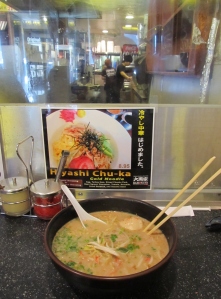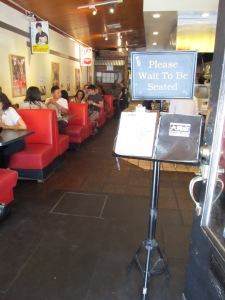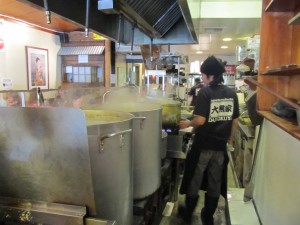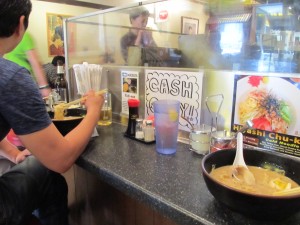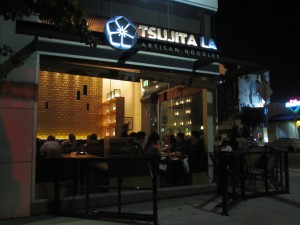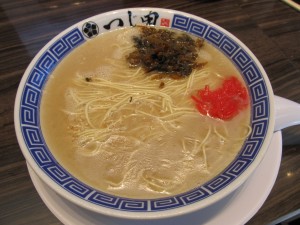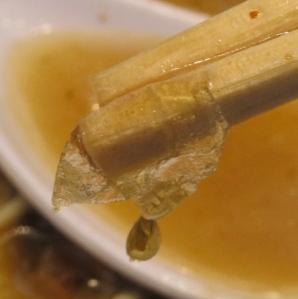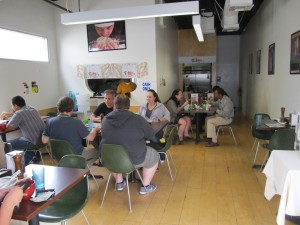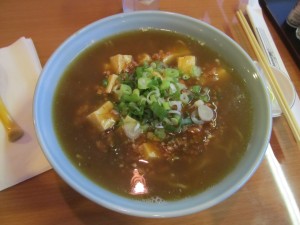By the time Lucky Peach magazine did their ramen issue in the summer of 2011, ramen shops and izakayas were already multiplying in many West Coast cities. The issue’s recipes and the unprecedented “Specifist’s Guide to the Regional Ramen of Japan” only fueled Americans’ interest in this popular Japanese food.
You can call this ramenia a hipster fad if you want. Dismiss many US versions as inauthentic. Go ahead and be a grump. But trendy or not, I’m enjoying the dish’s increasing availability.
On a recent vacation, I slurped my way through numerous luxuriant bowls in Los Angeles. Like many of the world’s great cities, LA is an energetic, multicultural mélange. It’s been fortunate enough to have a large Japanese population for a long time. As both a generator and early absorber of culture, it’s no surprise that LA is home to some of America’s best ramen shops. Although they’re all over the city, two neighborhoods boast the greatest density: Little Tokyo downtown, and Sawtelle on the West Side. Here’s a tour through a few:
1) Daikokuya
In the solar system of LA ramen shops, this place is the sun. Located in Little Tokyo on 1st just east of San Pedro Street, Daikokuya sits across the street from Mr. Pizza (“dinner special available,” says the sandwich board) and Las Galas (offering Philly Combo, Taco Combo, Burger Combo, Quesadilla Combo), and it’s so revered that it’s one of the only reasons many people come to Little Tokyo at all. I’ll be generous and assume that the people eating at Mr. Pizza are lost.
Other Little Tokyo shops top peoples’ best of lists: Aoi Restaurant next door, for instance, Chin-Ma-Ya of Tokyo, and Manten down on 2nd and Alameda. But the consensus is that Daikokuya beats them all.
Daikokuya is a small local chain with five locations: Monterey Park, Costa Mesa, Hacienda Heights, Arcadia and Little Tokyo. LT’s is a tiny shop. A few booths line the walls. A small counter surrounds the cook station. Demand usually outstrips seating, although on my last trip I got lucky and only had to wait about fifteen minutes.
Some people deride it because of its popularity: “The line is ridiculous! Screw that place! Why wait thirty minutes when Aoi rarely has a wait?” There’s some logic to the latter. Whether or not you think Daikokuya’s is LA’s best ramen, it is, without question, ridiculously good.
Daikokuya is known for tonkotsu ramen, a broth based on stewed pork bones. In Lucky Peach, chef David Chang says, “Tonkotsu is to ramen as Chicago deep-dish is to pizza: it’s a food group of its own, with a style that’s a thing apart, practically a different dish.” Daikokuya simmers their broth overnight.
As the menu says, “the process begins the afternoon before it ever reaches your table by boiling pork bones and joints in a large cauldren (sic) all throughout the night reducing at an undisclosed location. by the time it reaches the stove behind the counter the next day all the goodness is concentrated in our famous tonkotsu soup base.” Their broth is so good, they could cook it in a polluted brake drum for all I care.
This stuff is gravy, a rich, buttery comfort food that packs a salty porcine punch without being greasy. Amid its many layers, it has hints of bacon smoke. On my last visit, it was ninety something degrees out, yet the broth didn’t feel overpowering. And somehow it’s only $8.50! Bottom line: you’re not going to wait in line only to conclude, “That ramen was horrible.” The only regret you’ll have is seeing the bottom of your bowl.
Ramen is composed of four parts: the noodles, the broth, the tare (the salty flavor essence that helps determine the type of ramen it is) and the toppings. Daikokuya tops theirs with stewed bamboo shoots, green onions, a marinated hardboiled egg, bean sprouts and a sprinkle of sesame seeds. Their chijiri egg noodles are springy and chewy.
Their hardboiled egg is perfect, with a firm but soft orange middle and a white that absorbs the broth’s flavor.
One key topping is chashu. Daikokuya’s is perfect.
Chashu is simmered pork. Some shops use pork loin; others use pork belly, or kakuni. Different places also spell chashu differently: charsu pork, chasu pork, char siu, hyphenated and not hyphenated. Buttery, laced with ribbons of silky fat that melt in your mouth, Daikokuya sets the standard for this stuff.
Another thing about chashu: ramen shops never seem to put enough in their soup. They use it as a condiment, rather than a central component of the dish, which conflicts not with some culinary code of ethics so much as the American tendency to view meat as a meal’s centerpiece. Even if my desire for more pork is rooted in cultural relativism, I still want more. It’s frustrating to pay $9-15 for a bowl somewhere and still only find one or two slices in it, since no matter how filling the noodles and how savory the broth, you’ll always crave more of that soft, stewed meat. That’s why it’s such a score when you find surprise scraps floating in the bottom, entangled in noodles like incidental fish caught in a net. The lesson: no matter how much it pushes your bill beyond your normal “acceptable” level, always order extra chashu. Go work an extra shift at your job. Book overtime. Sell stuff on eBay. But order extra pork, especially here.
The menu also includes fried rice, chow mein and chicken teriyaki, but who would come here for that?
One guy next to me – a young Indian-American office type guy – leaned over his steaming bowl and didn’t look up once. A single earbud hung from his ear, snaking back to the iPod on the counter. He leaned over his bowl, and after finishing his noodles, spooned up the soup with the repetitive, medium-paced motion of a shovel moving ore from a rock pile, one load after another after another. Then, when he finished, he got up and left. The only time his gaze broke was when the waitress brought his check. She set it beside him and he lifted his head, but he didn’t meet her eyes. He muttered, “Thank you,” and resumed slurping.
2) Suehiro Café
Located on 1st Street, the main drag in Little Tokyo, this small café’s sandwich board lured me in. Weekend special, it said, tonkotsu ramen $5.99, down from $8.99. The usual crowd stood outside Daikokuya waiting for tables. I would’ve gone to Aoi instead, the little mom and pop place nearly next door – what some people call one of the last old school joints in Little Tokyo – but I’d missed their Sunday 5-9 hours. So I came here.
Suehiro is a small café. The sign by the door says “Maximum Capacity: 49.” A sign in back says “Thank you for helping Japan. We raised $12,518.” Drawings from kids line the walls and back hallway, all slipped into protective plastic sleeves presumably to protect them from tonkotsu broth splatter.
Even for six dollars, this ramen is more than utilitarian. The broth is well above average, the meat meaty and noodles springy. Any place outside of LA, this would likely be considered pretty damn good. The broth is much lighter than Daikokuya’s. It’s less porky, more golden in color, and tastes like it’s made with much more chicken, kind of like a Japanese matzo ball soup. With the popularity of heavy pork broth, it’s nice to have a range options.
Along with the soup, the highlight is the toppings: half an egg; spinach arranged in a generous bunch; nori seaweed; scallions; a slice of pink and white fishcake; and a liberal pile of soft, stewed bamboo.
It’s the traditional, pre-trend Tokyo ramen arrangement, and one whose bounty puts most ramen shops to shame. It would matter more if the pork was better. Toppings alone cannot carry ramen.
The chashu pork is good, but it’s the weakest link in the chain. It’s a thicker cut than Daikokuya’s, made not from belly but from pork loin or roll, which has been sliced and simmered until approaching tender. But it’s not as tender as I like.
Pork loin isn’t buttery or laced with the type of fat that makes belly meat so appealing. Although far from disappointing, it offers proof that being meaty is not enough. You have to have texture and flavor. The thing is, Suehiro gives you so much of it, which raises a deeper question: would you rather have less of the perfect meat, or a larger serving of the mid-range stuff? This is the place to find the answer.
Unlike iconic Daikokuya, Suehiro Café was filled with teenagers and tourists. If that sounds like a nightmare, it wasn’t as bad as it could have been. Five middle school girls sat at the long table to my left, accompanied by one adult, than mother of one of the kids. When the drinks arrived, one girl with a bob, big eyes and a striped, shirt said, “Ugh. This soda tastes like my medicine.” It was Calpico, the Japanese yogurt soda. The mother and daughter were Hispanic, one kid was white, and the others were, by their own description, “Indian, not Pakistani.” When sushi arrived, the daughter with the bob poked the wasabi with her chopsticks and said, “One time my dad and I bit into that. I thought it was, like, bell pepper, and I put it in my mouth and was like oh my god, oh my god.” She put some fish in her mouth and started shaking her head in disapproval. “I don’t like squishy tuna.”
One of her friends said, “Tuna is always squishy.”
“No,” the first girl said. “The red kind. I don’t like when it’s red.”
To my right, two young, gangly boys sat with their mother. The oldest kid was an early teen. He had feathered, emo hair, tight pants and braces with green rubber bands tied so tightly that they gave him a lisp. “I want a purebred,” he told his mom. “If I can’t get a purebred, I want a part Newfie.”
His mom flipped through one of the thin magazines that stood on a shelf by the front door. “There are lots of jobs in here,” she said without looking up, “restaurants you can work at.”
“Mom,” the younger boy said, “we’re not even in college!”
They each ordered variations of grilled chicken.
3) Tsujita LA Artisan Noodle
Part I: Ramen
You want to talk about ramen hype? With coverage in the LA Times, LA Weekly and on innumerable blogs and the tweetosphere, Tsujita had peoples’ attention before it even started serving noodles.
Tsujita is located in the Westside’s small but thriving Sawtelle neighborhood, an area sometimes called Little Osaka. Part of a small Japanese chain, this shop is the only North American branch, a fact that the ‘LA’ in the ‘Artisan Noodle’ name only vaguely hints at.
Tsujita offers two menu distinct menus. During the day (11am – 3:30pm) they focus on noodles: ramen and tsukemen. At night (6pm – 12am), they’re an izakaya, serving hot dishes and small plates, as well as a stellar omakase (“I’ll leave it to you,” aka chef’s choice) menu.
Tsujita offers three kinds of tonkotsu ramen: straight up for $8.95; Char-Sui Ramen for $12.95: “Ramen soup topped with slices of roasted pork;” and Negi Ramen for $9.95: “Ramen with thin strips of green onion.”
The charshu pork is really good. Tender, buttery, it even has the faint smoky taste of bacon.
Three thick slices float atop the noodles in the basic $8.95 bowl, all carefully placed alongside nori, bamboo and scallions. Although not as buttery as Daikokuya’s, Tsujita’s pork is delicious, so good that in hindsight I can see that I should’ve followed my own advice and paid the four extra bucks for the Char-Sui Ramen.
Three Jewish business people ate beside me. They kept playing what my own Jewish family calls the “Jewish name game”: guessing who’s Jewish based on their last name. One guy talked about trying to find a rabbi for his son who just left for college at Brown. When the waitress came to take their order, one man said, “I’ll have the rah-mahn.”
“Ramen,” said the waitress, scribbling it down.
“Yes,” he said, overcorrecting, “the rah-men.”
When their food arrived, they ate and talked and commented on their first bites. Businessman #1 said, “This is fabulous.”
Businessman #2 said, “Yes. Noodles are too hard for my abilities.” He was struggling to use the chopsticks to get noodles into his mouth.
The lone Businesswoman said, “We’re all here eating pork soup,” and they laughed. Through a mouthful of noodles, she described her father’s death and her mother moving into assisted living. “My mom is eighty-four, on JDate.”
Businessman #2 laughed. “Marketing is everything.”
Another highlight is the large selection of condiments on the counter.
There’s slivered red ginger, hot leaf mustard, sesame seeds, vinegar and pepper — you can dress your noodles to taste. If you like your soup spicy, add some of that mustard. This isn’t wet, hot dog style mustard. It’s the actual mustard plant, diced and leafy and seasoned to add heat but not too much. (Meaning, if you like your Korean food medium-hot, you won’t feel this at all.) It also adds flavor but not a pickly, tart flavor that’s going to overwhelm the soup.
The broth is thick and super porky, satisfying all the points on your palate with its dense flavors and silky body. They cook it for sixty hours. Besides this slow, careful simmering, part of Tsujita’s secret is fat. It comes from the pig parts, as well as a clear slick of lard on top.
Lard, you say? Before setting the bowl on the counter for the waitress, the cook spoons in some soy sauce from one metal bucket, then spoons in liquid lard from another.
Lest you think all Japanese food is healthy, know that, in Japan, it’s common to thicken ramen broth further by adding liquid lard. Some shops add butter. If that sounds like overkill, it is. It’s also delicious.
Take, for instance, Asahikawa ramen, a shôyu-based broth that blends chicken, pork and seafood. Since it’s located on Japan’s cold northernmost island of Hokkaido, Lucky Peach says, “The bowl is topped off with an insulating layer of lip-scalding melted lard to prevent the soup from losing heat in the frigid winter months.” In that same issue, David Chang says, “There’s a shop called Jiro in Japan that has become epically popular for having the most extreme tonkotsu-style broth, with so much pork fat emulsified into it that people talk of getting sick after eating it for the first time. But that doesn’t stop them from returning for the second go-round.” It’s a description that could fit countless junkies’ first use of heroin: getting sick then continuing using. What is it about pork fat that’s so seductive? And ‘emulsified?’ Any food whose preparation requires industrial and pharmaceutical terminology is going to take a toll on your body.
It gets crazier.
According to Lucky Peach’s “Specifist’s Guide to the Regional Ramen of Japan,” restaurants in the town of Kurume, on Japan’s southernmost island of Kyushu, serve their ramen with bits of fried lard. How you fry lard is beyond me, but determined chefs have found a way. And in the frigid west of central Honshu, “The twin cities of Tsubame and Sanjô lay claim to one of the most unusual and unhealthy ramen variants in Japan—an already rich broth made of pork bones, chicken, and sardines is topped with an almost obscene amount of suspended pork fat. There’s enough lard and raw white onion shaken on top that it’s almost impossible to make out the extra-thick, linguini-like noodles hidden below. They say that the salt and calories go a long way to replenishing the body after a hard day’s work making forks and spoons.”
A few words on lard skin:
Lard is a curious beast. Like mercury, it exhibits unusual physical properties that give it strange movements and qualities. Drizzled on hot soup, it liquefies, yet like the top layer of American sausage gravy, it quickly solidifies. Its resting state is congealed, and when it congeals in ramen, lard skin at rest resembles rice paper: a clear, delicate, surprisingly pliable layer. It contains tiny bubbles, and no matter how many times you stir it, as long as the soup is hot, the skin seems to reform. It sticks to everything, draping from the side of the bowl like a plastic pool cover, encasing the noodles, chopsticks and green onions as if this were sous-vide.
When you look at that reflective film, you know that that is exactly what it’s doing inside your arteries: coating everything and blocking passage. But when it’s on your tongue, you don’t care. You’ll care a few decades from now in the ICU.
In addition to compromising your health, the eating is fraught with danger. Even the tiniest drops will ruin your clothing. Bowls slide across the counter and leave oily traces that you don’t notice until they wet your arms. Pouring your soup into a take-out container requires surgical skill and the ability to disguise your terror in a way that maintains the illusion of masculinity. I even found a pool of liquid lard on the plate beneath my bowl. It had a semi-skin when I lifted it.
Broth like Tsujita’s elbows you in your bloated gut and proves that no matter how much Japan imports and celebrates Americana, it can also out-America America on uniquely Japanese terms. America invents the bacon cheeseburger topped with a fried egg and onion rings, and Japan lets some lard soup harden in your wheezing ventricle. Most ramen is a bacon cheeseburger. Although its complicated and protracted preparation means that it is not necessarily fast food, it does offer eaters a similar sense of comfort and a fatty rush, as well as a comparable physical abuse.
Despite the grim air of mortality surrounding this meal, there is much to love here, as evidenced by my consumption of the entire bowl and half of a second one. One highlight are the noodles. They’re fresh and chewy, closer to angel hair spaghetti than the springy, curly rubber bands most ramen eaters are used to.
Tsujita cooks them three different ways: hard, medium and soft. As the menu says: “Our recommendation is hard!” (That’s also how they like their arteries.)
If the bowls are smaller than the Daikokuya feeding trough you’re used to, then at least the flavor here more than makes up for it. Forget about size. This dish isn’t your penis. The soup’s so rich that a small order is sufficient. If you’re reading this and you’re American, though, you likely think that bigger is better, in which case, Tsujita makes you a dangerous proposal: buy a refill of noodles for $1.50, and the restaurant will give you free soup with it. This practice is called kaedama (替え玉), which translates to “extra noodles.” Since some customers may still be hungry after their meal, or might find the restaurant’s portions too small, some restaurants have a system where you can order extra noodles for a small additional fee. The Ramenaiac website says: “Ordering kaedama is a pasttime that originated with the Hakata style of ramen, in which portion sizes are traditionally smaller.” Many Japanese ramen shops require that diners have enough soup left in their bowl to accommodate the added noodles, which is why diners with foresight will resist drinking too much of the soup if they’re going to order a second helping. That’s why it’s generous that Tsujita includes more soup with the deal: Drink your soup, don’t drink it, they don’t care. You’re getting fresh soup either way. When the waitress brought my extra noodles, I realized the wisdom of not drinking too much of the soup: mine arrived in a new, clean bowl. The second was essentially a naked recreation of my first bowl, minus all the toppings – just soup and noodles.
I dressed it with sliced ginger and hot leaf mustard, then sprinkled it with sesame seeds. I was so stuffed that I could barely get through a third of it.
As Americans, we’re used to ordering more than we should, and eating more than is wise, so when you sit down at a place this good, it’s tempting to just assume you’re going to order kaedama. Eat like a horse, I told myself, you’re not in LA very often. It’s vacation. But Americans aren’t the only ones. A Japanese twenty-something came in, said hi to someone he knew at a nearby table, and in the time it took me to eat half my first bowl, he scarfed down two. His wallet was out to play before I finished slurping up my broth.
During the meal I felt fortunate to be here. Afterwards, I felt sick. No wonder: I’d eaten the gastro equivalent of wall insulation. After paying my bill, I tried to walk down Sawtelle but had to sit down in the shade to keep from throwing up. I pictured what that would look like: the bald gringo, vomiting into a planter. Bloated and remorseful, I tried to keep it together. Like the baby that I am, I text my girlfriend. She texted back the truth: “That’s what happens when you eat lard, baby!”
Part II: Tsukemen
Like those nauseated diners at Jiro, I returned to the source of my torment for more.
Besides ramen, Tsujita serves tsukemen. At first glance, this resembled a healthier soup, one based more on fish than pork and lard. “For 12 hours,” the website says, “the rich flavors of bonito and dried sardines are simmered together with pork bone, chicken bone and many vegetable creating a succulent fragrance of the sea that is powerful and beyond compare!”
I’m addicted to bonito dashi – that rich, umami-laced flavor based on dried bonito fish (katsuobushi) that tastes like a bacon-infused ocean. A whole, carefully simmered broth of that struck me as liquid heaven. I would have ordered it on my first visit, but once I read the menu’s tsukemen section it was too late; like a miracle, my ramen arrived less than three minutes after ordering. I came back a week later.
Since Tsujita’s so popular, there’s often a wait. If you get stuck waiting for lunch outside, drink some of the barley tea they offer in a large plastic jug. Waiting outside beside me, three twenty-somethings discussed their recent celebrity sightings. A young woman in a high-waisted brown dress said, “You saw Angelina Jolie a few weeks ago, right?”
Her friend, a young man in super skinny black jeans said, “A few years ago. I saw Russell Brand a few weeks ago at the airport.”
She nodded. “You see them at the DMV because they have to go there themselves.”
It’s not that kind of restaurant. It’s just that kind of city.
So, what is tsukemen? Pronounced skeh-men rather than tsoo-keh-men, it’s a cold-noodle dipping style of ramen. Despite its rampant popularity in Japan, it remains relatively unknown in the US. Lucky Peach gives a brief history: “As much a different concept of ramen as a regional style, undressed tsukemen noodles are dipped into an accompanying bowl of fishy, barely diluted broth before slurping. Though tsukemen has taken the ramen world by storm of late, it traces its history to the early postwar era, when the now-legendary ‘God of Ramen,’ Kazuo Yamagishi of Tokyo’s Taishôken, decided to offer his customers soup and noodles separately.”
Tsujita is one of the only places on the West Coast that serves tsukemen, reproducing stateside one of the best recipes in Tokyo. In his 2011 LA Weekly article, Jonathan Gold calls the dish “life-changing” and describes a noodle blogger/cognoscenti known as “Rameniac” who flew from London to LA just to eat it. As Garrett Snyder puts it in his 2012 LA Weekly article, “The tsukemen broth [at Tsujita] starts out as the same tonkotsu base as the ramen, except it’s simmered and reduced for 60 hours, then fortified with bonito until it’s as viscous as motor oil. You dip your noodles, chewy, bouncy and cooked al dente, into the umami-rich liquid, then slurp up the lubricated strands. The proper technique for enjoyment involves consuming one third of the noodles with the broth, the second third with a dash of togarashi spice, and the final third with a squeeze of lime. Although you might have a hard time getting past the pure animalistic bliss of the first section.”
Los Angeles magazine included Tsujita as #88 in their 2012 “101 Cheap Eats” summer roundup and described chef Kenta Ikehata as a tsukemen fanatic who moved from Tokyo to LA to open Tsujita’s first US location. “[H]e’s been known to toil into the wee hours to perfect his pungent broth,” it said. “All that labor has yielded a bowl of silky soup unmatched in L.A.”
The Tsujita menu offers directions to bring out the emergent flavors:
Enjoy Tsujita Tsukemen Style in 3 Stages,
Begin by dipping the noodles into the accompanied soup broth until you have enjoyed around 1/3 of the noodles.
Please squeeze the lime juice over the noodle at the timing you like.
After the noodle is finished you can enjoy the soup at the end by pouring some addition soup stock.
The taste changes dramatically with each stage. Tsujita Tsukemen style at best.
The menu didn’t mention lard, though, and this time I arrived prepared.
I asked the waitress if she could hold the lard in my tsukemen. She shook her head no.
“You can’t tell them not to add lard?” I said.
She said, “Oh, it’s already in the soup.”
“That’s okay. Can you tell them not to spoon more on?”
Yes, she said she could do that.
Some people might see this as sacrilege, akin to asking Katz’s Deli to make their famous pastrami sandwich without the rye bread, but I disagree. Why take such great pains to source and combine specific ingredients only to ruin the dish at the end? Japanese soup stocks have some of the most complex, satisfying flavors on earth. Wanting broth straight wasn’t sacrilege. Dumping lard in there was. I just wanted to eat without feeling ill.
The broth was incredible. Potent and complex, porky and oceanic, rich and savory — like nothing I’ve ever tasted. It was also pretty greasy. A layer of clear fat floated atop the dark, cloudy broth like spillage in the Gulf.
In that 2011 LA Weekly article, Jonathan Gold says, “If you try to taste the tsukemen dipping sauce alone, somebody probably will stop you before the spoon makes it up to your lips.” Either no one bothered to stop me, or they didn’t see me spooning it to my mouth. Same with leftovers: “You are permitted but not encouraged to take home leftovers,” he says. The waitress with the ramen was more than happy to let me take what was left of my second bowl home. By the time I ate all my noodles, though, I was so larded out that I didn’t even want to take the tsukemen home. Less than half the broth remained in the bowl.
Rare or not, I was happy to leave it there. All that flavor, the cooks’ labor, the meticulous ingredients – burying it beneath so much grease seemed more egregious than like pouring generic barbecue sauce over Central Texas brisket that had been smoked for two days.
Maybe my stomach’s too sensitive. Maybe I have a prejudice against grease. I would say that Tsujita just barely missed the mark if I didn’t have the unbearable urge to eat there again.
4) Miyata Menji
Miyata Menji’s small, Spartan space presents a far more welcoming environment than you’d expect from a narrow expanse of white walls and wood floorboards.
A Plexiglas case of cookies stands by the door. Between the cookies and the kitchen, a large group of construction workers sit at the large center table, slurping noodles and sharing boisterous conversation.
Unlike many places, Miyata Menji has chosen the path of simplicity. It offers two items: tsukemen and tonkotsu ramen. Although they serve specials like a curry ramen, their simple menu means they do everything well.
Miyata’s soup didn’t turn my stomach the way Tsujita’s did. In fact, when I asked the hostess if they added lard, she tried to conceal her confusion with a smile. “Lard?” she said. “What is lard? I don’t think so.” There was a sense of finality that countered the rising intonation of her final sentence.
And unlike Tsujita, there was no wait. Miyata’s hostess greeted me at the front door with the traditional “Irrashaimase!,” or “Welcome!” in Japanese, and let me choose a table. She was super sweet and accommodating. Wearing a bright yellow Miyata t-shirt, a dark apron and a white headscarf decorated with Japanese characters, she buzzed around the room refilling water glasses, seating new arrivals and smiling when she caught your eye. A few bites into my meal, she appeared beside my table. “Everything good?” she said. She rubbed her belly. “We have extra noodle if you’re still hungry.”
Part of a small Osaka-based chain, Miyata is a recent addition to Sawtelle’s ramen kingdom: it opened on March 21, 2012, the first American branch in the company. As the LA Weekly reported right after the opening: “Owner and ‘famous comedian’ Menji Miyata wants to spread his food to the world, explains vice president of operations Akihiro Kanda. The 26-seat, cash-only restaurant, which opened on March 23, has yet to make any public announcements of its debut and is relying heavily on word of mouth and foot traffic for customers. ‘The ramen business is blowing up,’ says Kanda.”
A tiny Japanese woman ate an enormous bowl of tsukemen next to an enormous Hispanic kid in a maroon Adidas soccer shirt, eating an enormous bowl of ramen.
While I ate, a brusque middle aged Asian woman stepped inside to grab a menu. When the hostess greeted her, the woman barked, “Do you have cold noodle?”
“Tsukemen?” said the hostess. “Yes.”
“No,” the woman said in unsteady English. “Cold noodle.” They exchanged words I couldn’t hear. Her eyes darted around, and then she left.
The menu describes their take on tsukemen as “steamed noodle with anchovy cabbage, white shallot, grated cheese & vegetable ptage, pork minced, tomato crouton.” It notes: “If you are allergy or dislike to cheese, please tells staff. We are able to make it without cheese.” Looking around, it seemed that most people ordered the tsukemen.
Although I wish I’d ordered it, too, Miyata’s tonkotsu is the stuff of dreams. It’s rich without being heavy, fatty without being greasy, porky but not too salty. It’s the same approach that Daikokuya takes, finding flavor in the slow simmering of broth and adding fat back in, rather than adulterating perfect broth with lard. Like Suehiro’s, the broth here is golden like matzo ball soup, and its medium-body is silky in your mouth.
As usual, they top their soup with scallions, but in a twist that’s unusual among LA’s ramen shops, Mikyata garnishes their soup with diced tomato.
The tomato adds a nice tartness and a soft, fresh texture to each bite, a counterpoint to the hot broth. It doesn’t alter the flavor of the soup, though, which is nice. In what almost seems a cue from Vietnamese noodle dishes, they sprinkle on white shallots and fried slivers of garlic. The combination adds a deep, satisfying punch to the broth that fans of Kumamoto prefecture’s garlic-infused ramen might appreciate.
Another unusual twist: instead of using charshu pork, Miyata uses terisyabu – teriyaki beef. Granted, there isn’t much of it, and maybe it’s more a cost-saving measure than a culinary decision, but the thin strips are flavorful and have that chewy, resilient texture that makes teriyaki so good.
You can add extra terisyabu for $2, and more fresh tomato for $1. Ramen and tsukemen are both $8.75 for a regular size bowl. A large size is available for when you feel like an animal.
While chewing terisyabu, I started thinking: after eating all this pork ramen, what was it doing to my body? If you want a biased opinion, famed Tokyo ramen shop Nantsuttei offers a nutritional analysis of chashu pork. (The lead singer of the Morning Benders, Chris Chu, told The New York Times that of the twenty-five or so bowls of ramen they ate on a 2012 Japanese tour, Nantsuttei’s tonkotsu “blew everything else out of the water.”). Nantsuttei says: “Pork is a great source of good quality protein and contains an abundance of vitamin B1. Vitamin B1 is highly effective in relieving fatigue and is necessary to change glucose to energy in the liver. Vitamin B1 also helps to stabilize your autonomic system and relieves the symptoms of menopause and autonomic dystonia. Pork also contains compounds that reduce cholesterol and help prevent hardening of the arteries. By combining with garlic, which contains scordinin, you can feel the full effect of fatigue relief!” Oh, pork actually protects your arteries from hardening? Who knew. (Notice their website discusses the nutritional profile of green onions, garlic and eggs, but doesn’t list any info about their soup’s salt, fat or calorie content.)
Daikokuya, on the other hand, has taken a more subtle, evasive approach to the subject: “Currently we do not have the nutritional info for our food. It is something we will do in the future, but it is an involved process. Right now we are a small restaurant chain of 4 locations.. The California law requires restaurant chains of 20 or more locations to provide nutritional info.. so we still have time lol. Alternatively, you could look up general item’s nutritional info such as ‘gyoza’ etc.. and find a possible ball-park idea of what it might be. Of course, our recipes are not necessarily the same, so it would not be entirely accurate. Eventually we will have the analysis done.” Now that’s a line of BS I can respect.
Miyata’s only problem is location: the shop is easy to miss. Set off the street, on the edge of a small parking lot, the tiny storefront is composed mostly of a doorway and a yellow awning beside a blank wall.
Walking by, it looks like it’s part of the neighboring hardware store, rather than an appetizing restaurant.
Because it’s set back a ways, Miyata sets a sandwich board by the sidewalk to draw attention. I’d say that I hoped that tactic was working, but the crowd at 12:30 on Tuesday proved that it was.
Despite the seductive decadence of Tsujita, Miyata is my favorite noodle joint on Sawtelle. Simple, savory, with a relaxed atmosphere and friendly staff, eating here is like eating at a friend’s house, expect they leave you a bill. As the red paint on the parking block in front of the door says, “Thank you!! See you again.” Oh hell yeah you will.
5) Asahi Ramen: Japanese Noodle House
If we judged a restaurant’s prospects by its appearance, we’d miss some of the best food on earth. A birrieria with bars on the windows whose screens buzz with flies? A man grilling meat on a cart on a downtown sidewalk? Unlike the covers of books, food often works on the counterintuitive, uglier-the-better principle (UTBP). In fact, when it comes to ethnic, neighborhood restaurants, you should ignore the setting entirely. In Los Angeles Magazine, food writer Zach Brooks goes further, offering two rules: “Avoid Anything ‘Clean’ and ‘Real’ – These are code words for ‘expensive’” and “Look Past the Surface – Love the ambience and friendly staff at your favorite restaurant? Of course you do. Know who pays for that? You.” That’s good advice.
Asahi Ramen isn’t dirty. It isn’t cramped or even faintly crusty. Rather than a hole in the wall, it’s the sort of benign brood cell you find in suburban strip centers next to office parks. Instead of overpriced iceberg lettuce salads and garbage sub sandwiches, it serves twelve types of ramen, more varieties than any other place on Sawtelle.
An hour before closing on Saturday night, the place was jumping – only two vacant tables in a room full of about ten. As the restaurant’s website says, Asahi is a place “frequently visited by film stars, so one wall is like a small gallery with star photographs covering it.” I missed the wall of photos, but the place was a sea of civilian faces.
A middle-aged guy with his girlfriend knocked over his cup of Diet Coke. Ice and soda cascaded over the edge of the table, onto the floor. She giggled and handed him a napkin. “Why is that funny?” he said.
She leaned back in her seat and tightened her ponytail. She said, “It is,” and smiled at me as if we had an inside joke. I smiled back. I couldn’t deny it was funny.
An older woman with buggy eyes and overprocessed big black hair sat next to me with her young daughter and said nothing. The kid watched a kid’s show on a smart phone with the volume turned up. The mother stared past her, past me, straight out the window, her chin resting on her hands as if the life had just left her. Only when the food arrived did the two speak.
“Would you like a fork,” the mother said, “or chopsticks?”
“Fork,” the kid said. Then they ate.
Nearby, a young man ate by himself, slowly and methodically, and drank a Coke.
A jovial couple behind me spent a lot of their time laughing and swapping stories. When the server came by, the man asked, “Can we get this to go?” He and his girlfriend said they loved their ramen but were full. “As you eat it,” he said, “it expands. It grows and grows. You have to watch as it reproduces!”
Japan is home to numerous regional ramen varieties. Despite this diversity, ramen broth is often divided into four basic types: pork-bone based ramen (tonkotsu), salt-based ramen (shio), miso-based (fermented soy bean paste) and shôyu-based (close to soy sauce). Nine of Asahi’s twelve ramen are shôyu-based, but each has a distinctive flavor, due as much to its toppings as its broth. There’s Wakame Ramen (“Noodle with seaweed, bean sprouts, cooked bamboo shoots in a soy sauce soup”), Moyashi Ramen (“Noodle with sautéed bean sprouts and shredded pork in soy sauce soup”), Shio Ramen (“Noodles with roast pork, ½ egg, bean sprouts, cooked bamboo shoots in clear soup”) and Kimchi Ramen (“Noodles with pan fried kimchi and shredded pork in soy sauce soup”).
I ordered the Mabo Ramen.
I’d eaten so many varieties of tonkotsu in the last few days that I wanted to taste something completely different. Often spelled mapo doufu, mabo tofu is one of the most well-known Chinese dishes in Japan, Korea and the West. It’s simple: slices of tofu seasoned in a red, chili- and bean-based sauce, whose flavor comes in varying levels of heat that frequently reaches the popular Sichuanese “numbing” level. Asahi’s menu describes their Mabo Ramen as “Noodles with spicy sauce with ground pork and tofu in soy sauce soup.” It was spicy but not overpowering, just warm enough to have heat and lots of flavor. But the broth was mediocre.
As Asahi’s website puts it: “The broth is derived from meats and 10 different types of vegetables and steeped for over 24 hours. The broth requires vegetables of which 7 would easily spoil, so the profound taste of the broth is very special to the dish.” Maybe the owners prefer the taste of shôyu soups. Maybe they want to specialize in a type that few other LA ramen shops serve, make it their niche. Or maybe shôyu ramen is just easier to make. The problem is, you can taste the difference. It’s not that Asahi’s broth is cheap or lackluster. It’s clearly labored over. It’s just that, for all that simmering and those ten different vegetables, the result is too simple a taste for my palate. Even though I’m partial to stronger flavors – briny, porky, oceanic – Asahi’s stock is savory and salty but lacks depth. You won’t find a whiff of bacon smoke. You won’t find the complex layers of tartness, garlic or butter the way you do at Miyata, or the concentrated seafood character of Tsujita’s tsukemen. The flavor that dominates here is salt, not overpoweringly, but in a simple way. It’s silky on your tongue but flat, which is disappointing considering their range of offerings.
I initially saw the menu hanging in the window and thought, “I want them all. This will require numerous trips.” I ate one bowl and thought, “Eh, next time I’ll eat the Hiyashi Chuka (“Cold noodles with egg, seaweed, cucumbers, and bean sprouts in sweet sour sauce”) and tsukemono pickles.” Maybe shôyu broth just isn’t for me, in which case, I’m a poor judge of quality. Maybe this is actually what ramen is supposed to taste like, and the heavy porcine gravy version is just the now version, the “extreme” next-level, take-it-over-the-top trend soup. Hard to say. I like porky, though.
If this was a person’s first experience of authentic restaurant ramen, they would be missing out on the depth of experience, but Asahi still has many charms. A small bowl of delicious, sautéed cukes accompanies each soup. Nice and crisp, they’re seasoned with what tastes like salt and sesame oil. The staff is super friendly, very attentive. Prices are reasonable and servings large. And unlike Tsujita, overindulgence at Asahi won’t make you ill. If there’s any post-meal regret here, it’s that I don’t live close enough to work my way through their menu.
In addition to ramen, Asahi serves yakisoba, sara udon (katayakisoba), oshitashi (boiled spinach in a sweet sesame sauce topped with shaved bonito), ban ban ji (“marinated shredded chicken and thinly sliced cucumeber”) and mabo rice, even egg flower and wonton soups.
As I ate my soup, servers repeatedly walked to the front of the store to close the door behind customers. The door locks in an open position. I can only imagine how annoying that would be to do all day. If the servers were irritated by it, they concealed it well. When the clock struck ten, they flipped the “open” sign and kept refilling diners’ water, as the rest of us slurped soup and paid our checks.
6) Jinya Ramen Bar
Despite the number of meals I had on Sawtelle, I never got around to eating at Jinya. But for those planning a trip to the area, it’s worth mentioning. As LA Weekly said during my visit to LA, Jinya serves “Tonkotsu ramen – including a black version with black garlic oil and a spicy red version – soupless ramen, gyoza and organic tofu made to order at your table.” The idea that I missed spicy red and black versions makes me ache with regret. That I walked by this joint and didn’t go in – what an idiot I am. LA residents, I ask of you: please slurp a bowl for those of us who cannot.
7) Hakata Ramen Shin-Sen-Gumi
Another venerated place I didn’t get to eat is Hakata Ramen Shin-Sen-Gumi. It’s a small chain with a few branches in LA and one in Tokyo. The Little Tokyo location is on Central Avenue, south of 1st. In their June, 2012 Cheap Eats round up, Los Angeles magazine said of it: “Mitsuyasu Shigeta’s chain of Shin-Sen-Gumi restaurants serves everything from yakitori to hot pots. The draw at the latest branch in Little Tokyo is a pork-centric hakata-style ramen that’s meant to be customized. From the firmness of the noodles to the thickness of the broth to the flecks of fried pig’s ear on top, you get to choose. » 132 Central Ave., Little Tokyo, 213-687-7108.”
The restaurant’s website explains their unique offering: “Hakata ramen originated in Hakata city located north west of Kyushu . The main characteristic of Hakata ramen is the white, thick soup that is made from pork bones, also called Tonkotsu (pork bone) soup/ramen. Some of the other differences in character it has from other types of ramen are thinner noodles, and the simple decorative toppings of cha-shu , chopped scallions, red colored ginger, and sesame seeds.
In our restaurants we use carefully selected Berkshire pork and filtered water. It is cooked for more than 15 hours with a strong flame from a commercial grade jet burner to make our unique Tonkotsu soup.
Some of you may think, Tonkotsu soup is just a soup, it can’t be difficult to make. soup is like a living thing that must be carefully monitored. The water level, temperature, and strength of the flame must be maintained in order to create the best consistency of coloring as well as taste. Otherwise we wouldn’t be able to open our restaurants, as it has happened a few times in the past. We take great pride in our work and food that we serve. We will not be second best!”
I admire their obsessive dedication. It’s one more reason that I need to go back to LA.

